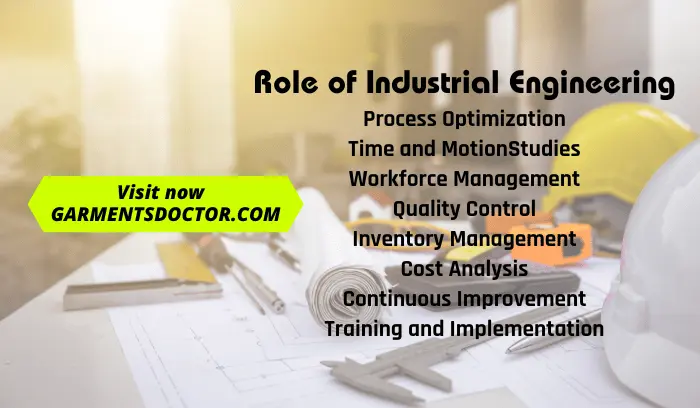Introduction of IE Duties and Responsibilities
Industrial Engineering (IE) is a process of engineering that focuses on optimizing complex processes, systems, and workflows to enhance productivity and efficiency across various industries. In the garment industry, IE plays a crucial role in streamlining manufacturing processes, improving quality control, and maximizing resource utilization. Industrial Engineers analyze operations, identify areas for improvement, and implement strategies to drive continuous enhancements, ultimately contributing to the organization’s overall success.
Defining IE Duties and Responsibilities
Industrial Engineers in the garment industry are responsible for various duties to improve operational efficiency and productivity. They optimize complex processes and improve industrial systems to increase efficiency and productivity, which are the main duties and responsibilities of industrial engineering. By identifying bottlenecks, inefficiencies, and opportunities for enhancement, industrial engineers ensure the smooth operation of garment manufacturing processes.
Role of Industrial Engineering in Garment Manufacturing
- Process Optimization
- Time and Motion Studies
- Workforce Management
- Quality Control
- Inventory Management
- Cost Analysis
- Continuous Improvement
- Training and Implementation

Key Duties and Responsibilities of Industrial Engineering in Garment Industry
- Collecting the line loading plan from the Planning Department to ensure production targets are met.
- Attending Pre-Production (PP) meetings to discuss and plan.
- Collecting size set samples and creating operation bulletins.
- Creating paper layouts based on the operation bulletin to guide production.
- Discuss technical issues with the maintenance person in charge to ensure machines and equipment are functioning properly.
- Collaborating with the floor in charge to ensure the paper layout is properly implemented on the production floor.
- Check daily non-productive time (NPT) and reduce machine breakdown time to maximize productivity.
- Creating a layout according to the paper layout, ensuring efficient production.
- Balancing the production line according to Standard Minute Value (SMV) to maximize efficiency.
- Identifying bottleneck processes and finding solutions to improve efficiency.
- Setting daily targets based on the learning curve, ensuring production meets or exceeds expectations.
- Conducting 1-hour production studies in required processes as needed.
- Monitoring input and output daily to ensure production is on track.
- Give daily production targets and follow up on production achievements to ensure targets are met.
- Conducting hourly production follow-ups to track progress and address any issues that arise.
- Monitoring 5S-related activities every day to ensure a clean and organized workspace.
- Cross-checking thread consumption for every new style to ensure accurate production.
- Ensuring efficiency according to the learning curve and budget to maximize productivity.
- Designing and arranging workstations to optimize efficiency and minimize physical strain on workers.
- Developing operators’ motion by correcting faulty motion of layers to improve efficiency.
- Reducing Work in Progress (WIP) and problem-solving to improve production flow.
- Reducing line setting time or throughput time to maximize productivity.
- Implementing efficient systems to optimize production processes.
- Providing training and guidance to operators on production processes and procedures.
- Operator skill matrix report every month.
- Properly utilizing manpower by reducing unnecessary helping processes to streamline production.
- Establishing a meeting between QC and operators to review critical points of the style and ensure quality production.
- Preparing a daily Man/Machine report to track progress and identify areas for improvement.
- Developing cut-to-ship ratio and balancing finishing manpower to maximize efficiency.
- Creating a daily cutting and sewing finishing efficiency report to track progress and identify areas for improvement.
- Implementing Kaizen and ECRS methodologies to continuously improve production processes.
- Making weekly and monthly machine and manpower forecasts to ensure adequate resources are available for production.
- Creating a monthly efficiency report to track progress and identify areas for improvement.
Conclusion
Industrial engineering duties and responsibilities are essential to ensuring efficient and productive manufacturing or production processes. From collecting line loading plans to creating monthly efficiency reports, optimizing production processes, identifying areas for improvement, and implementing solutions. Utilizing skills in process analysis, problem-solving, and collaboration, and help ensure that production targets are met. Also, industrial engineer duties and responsibilities depend on the industry.
Also Read: GPQ Job Responsibilities In Garments Industry: Full Overview
FAQs (Frequently Asked Questions)
What are the duties of an industrial engineer?
2. Time and Motion Studies
3. Workforce Management
4. Quality Control
5. Inventory Management
6. Cost Analysis
7. Continuous Improvement
8. Training and Implementation


